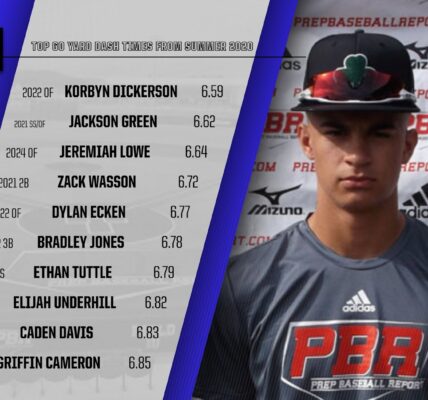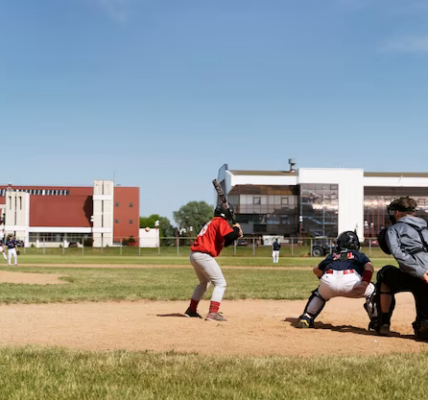The question of which position in baseball is considered the hardest often incites passionate debates among fans and players alike. The answer, however, isn’t as straightforward as it seems. Each position in the game presents its own unique set of challenges and requires subtly different skills. To delve deeper into this fascinating topic, let’s dissect the intricacies and demands of each role, and see why each one could potentially be argued as the most arduous position in the sport.
Pitcher
In the realm of baseball, the position of the pitcher stands as the central pillar upon which the game’s outcome sways. It’s an arduous role often seen as the most pivotal in the entire sport.
Being a pitcher isn’t just about hurling a ball towards a batter. It embodies strategic thinking, physical prowess, and mental resilience, making it a contender for the most challenging position on the field.
The Pitcher’s Core Responsibilities
A pitcher’s chief aim is to outmaneuver batters and halt the scoring of runs. This responsibility puts them under intense scrutiny and immense pressure, particularly during high-risk scenarios and crucial gameplay moments. This immense pressure isn’t solely a result of their pivotal role, but also the expectation for precision and performance consistency.
The Art of Pitching
A successful pitcher needs a wide-ranging arsenal of pitches at their disposal. The mastery of various pitching techniques, coupled with knowing the exact timing for each, can drastically upturn a game.
The ability to exercise extreme control over their throws is also crucial. A successful pitcher must accurately place their throws, exploiting the batters’ weaknesses while minimizing their strengths.
Shortstop
In the strategic game of baseball, the shortstop position is frequently cited as one of the most challenging to master. Covering a significant part of the infield and often the patron of short fly balls from the outfield, the shortstop’s role is a relentless dance that demands exceptional agility and versatility.
The Demands of the Shortstop Position
As the most dynamic position in the infield, the shortstop is expected to be agile, quick-thinking, and have a keen understanding of the game’s dynamics. They must be adept at swiftly moving to their left and right, and even venture into the outfield when necessary.
Shortstops: The Key Players in Scoring Outs
To highlight the importance of a shortstop, consider their involvement in the game’s outs. With a significant number of balls flying towards their field area, they inevitably play an essential part in creating opportunities for outs. This involves covering second base during double plays and stolen base opportunities, serving as the cutoff for throws from the outfield, and fielding balls hit between third and shortstop. A shortstop without a strong, accurate arm is like a king without his crown, considering the long throws they often need to make to the first base.
The Leadership Role of a Shortstop
In addition to the physical demands, the shortstop position also bears a distinctive leadership role. Often considered the unofficial captain of the infield, the shortstop is expected to communicate valuable instructions relayed from the manager or coaches to the rest of the team. On a pop fly, it’s the shortstop who calls the shots, having the authority to signal other players. The shortstop’s leadership role, combined with their significant involvement in gameplay and the physical demands of the position, makes it one of the most challenging roles in baseball, demanding a delicate balance of physical prowess and strategic acumen.

Catcher
Another role that’s often placed in the conversation regarding baseball’s hardest position is the catcher. Highly distinct in the baseball landscape, the catcher position warrants an unparalleled level of involvement in the game.
The Catcher’s Involvement in Every Pitch
Serving as the recipient of every pitch, a catcher is entwined in every tiny ripple of the game. The job demands a deep-seated understanding of both the pitcher’s arsenal and the opposing batter’s tendencies, making the catcher a central player in every unfolding drama on the field.
The Role in Calling Pitches
The catcher not only receives the pitches but is also a significant determinant of their nature. Knowing when to call a fastball or a curveball relies on their understanding of the pitcher and batter. The ability to decipher the best call for each situation makes the catcher a chess player, continually making crucial decisions that could sway the game’s outcome.
Arm Strength and Quick Decisions
Arm strength is another significant attribute for a catcher. Thwarting base stealers or trying to pick off runners requires not only a strong arm but also quick reflexes. A split-second delay can mean the difference between a successful out or an advancing runner. Catchers must respond swiftly and accurately, demonstrating their physical capabilities and tactical understanding.
The Physical Toughness of a Catcher
The catcher position is not for the faint-hearted. It requires unparalleled physical resilience, as catchers are often at the receiving end of errant pitches or foul balls. While their protective gear offers some respite, the harsh impact of fastballs and the discomfort of wearing the equipment in scorching summer heat are part of a catcher’s life.
The sheer physical and mental demands that are woven into this unique position makes it one of the most challenging in the game, emphasizing the catcher as a symbol of endurance, resilience, and strategic acumen.
Center Field
The rigors and demands of baseball don’t limit themselves to the infield. The outfield holds its own challenges, and arguably, the center fielder wears the heaviest mantle amongst outfield positions. Their extensive jurisdiction and the unique perspective make center field a tough contender in the debate of baseball’s most challenging positions.
The Center Fielder: A Cornerstone of the Game
In the vast expanse of the baseball outfield, the center fielder reigns supreme – tasked with covering the most ground amongst the three outfielders. This role carries a critical responsibility, requiring a unique blend of physical athleticism and alertness, akin to the shortstop in the infield.
The Demands of the Center Field Position
- Quick Reaction Time: A center fielder must be able to spring into action at the crack of the bat, reacting almost instantaneously to the ball’s trajectory. This requires not only a keen eye but also nimble feet to reach far-flung balls;
- Arm Strength: A powerful throw, often coined as ‘a cannon for an arm,’ is a prerequisite for a center fielder. They are the last line of defense against advancing runners, making their ability to relay the ball back to the infield of utmost importance;
- Coordination with Fellow Outfielders: The center fielder doesn’t work in isolation. They must seamlessly coordinate with the right and left fielders, either taking charge of balls hit in the gap or providing backup when needed. This coordination underscores the importance of teamwork in the outfield.
The Challenge of Reading the Ball
With a central location in the field, the center fielder faces the unique challenge of correctly assessing a batted ball’s direction and speed from a head-on view. This perspective makes it tricky to gauge a ball’s flight path and exit velocity, making it a challenging task even for seasoned professionals.
The Iconic Center Fielders: A Testament to the Position’s Demands
The center field position has been graced by some of the most iconic figures in baseball history – Willie Mays, Mickey Mantle, Ken Griffey Jr., and Mike Trout, to name a few. These legendary players’ unmatched talent highlights the scale of challenges faced in the center field and the level of skill required to master this demanding position.
Third Base
In the intense and action-packed world of baseball, the third base position holds its own unique challenges. Dubbed as the ‘hot corner,’ it’s a position that requires exceptional reflexes, superior handling, and a forceful arm. While the area under its jurisdiction may not be as vast as the shortstop or center fielder, the third base position ranks high in the list of baseball’s most demanding roles due to its highly reactive nature.
The High-Velocity Challenge
The nickname ‘hot corner’ isn’t a frivolous attribution. It originates from the scorching line drives frequently hit towards the third base, often at incredibly high speeds. Reacting to these high-velocity balls requires a lightning-fast response time, making this position a hotbed of action.
The Skillset for a Third Baseman
- Reflexes: The ability to react quickly to sudden line drives is indispensable for a third baseman. The stark absence of reaction time can turn a hit into a potentially dangerous situation, which underlines the need for quick, cat-like reflexes;
- Hand Control: Soft hands, a term often used in the infield, refers to the ability to smoothly field a ball without bobbling or dropping it. A third baseman needs this essential skill to handle those wickedly fast grounders and line drives commonly associated with the position;
- Arm Strength: Another weapon in a third baseman’s arsenal is a powerful arm. Given the long diagonal throw to first base, this attribute can prove to be a game-changer during those tight plays.
The Tactical Intellect of a Third Baseman
Aside from the physical demands, a third baseman is also a strategic player on the field. They are often the first line of defense against bunts or slow rollers that hurdle past the pitcher’s mound. Precise judgement and quick decisions are vital in successfully thwarting such plays.

Right Field
Right field in baseball can be perceived differently depending on the level of the game that is being played. The difficulty level at which one experiences playing right field tends to vary significantly, presenting unique challenges at every level of proficiency in the sport.
At introductory levels like Little League and high school baseball, the right field position is often viewed as relatively easier. This belief stems from the fact that most players are right-handed batters who tend to pull the ball towards the left side of the field. This batting habit significantly reduces the number of putout opportunities for the right fielder, making the position less stressful than others.
However, as players climb the ladder of expertise, the complexity of playing right field escalifies. One of the primary reasons for this increase in difficulty is the exceptional arm strength required by a right fielder.
Why Does a Right Fielder Need an Exceptional Arm Strength?
In a game where every second and every inch matters, a right fielder’s arm strength can often prove to be the difference between victory and defeat. A right fielder must possess not just an ordinary throwing arm, but an arm that could rival the strength of the pitcher’s.
The rationale behind this requirement is the formidable throw from right to third base that a right fielder is often expected to make. This throw, owing to its distance and difficulty, can be a game-altering play and, therefore, calls for an individual with a remarkable arm strength who can execute it effectively.
While the right field position poses its unique challenges, it also offers some respite to the player. One advantage of being a right fielder is the proximity and support offered by the center fielder, which can ease the pressure during critical moments of the game.
Furthermore, at professional levels such as the Major League, most batters continue to hit right-handed, which invariably reduces the frequency of putout opportunities, thereby decreasing the overall difficulty of the position.
Second Baseman
The second base or middle infield position in baseball, despite its inherent challenges, is often considered one of the less taxing roles in the game.
A noticeable advantage for the player in this position is the compact distance they would have to throw–the shortest distance among all positions on the field, in fact. This advantage allows the second baseman to leisurely toss the ball to the first baseman, yet still effectively getting the runner out in a timely manner.
While being a second baseman doesn’t demand the level of athleticism required for positions like shortstop, it does require a certain level of agility. This is because the second baseman is responsible for covering the balls hit right up the middle of the field. However, in scenarios where shortstops exhibit exceptional speed and athleticism, they can occasionally be seen taking over some of the duties traditionally assigned to the second baseman.
Nevertheless, serving as a second baseman isn’t without its challenges. One of the key responsibilities they bear is executing double plays, which necessitates excellent coordination and timing. Additionally, they are occasionally required to cover second base during a stolen base attempt.
Although the position of a second baseman is generally considered less challenging relative to the others, it would be erroneous to undermine its importance. The game of baseball is akin to a well-oiled machine, where each position, regardless of the level of difficulty, plays a vital role in ensuring the smooth functioning of the game.
Key tips to remember while playing second base include:
- Develop a strong hand-eye coordination to manage balls hit up the middle;
- Practice makes perfect. Regular training can help enhance your footwork and throwing skills;
- Maintain a constant communication with the other infielders, especially during potential double play scenarios.
Left Fielder
Often considered one of the less demanding defensive positions in baseball, the role of a left fielder possesses its own unique set of characteristics.
Occupying the left field, these individuals do not require exceptional athletic prowess or speed, courtesy of the support provided by the swift and skilful centre fielder. Moreover, unlike their right field counterparts, left fielders are not burdened with the task of making long throws to third base due to their position on the field.
In youth level baseball, the left field takes on a higher degree of importance, predominantly due to the high ratio of right-handed batters. This leads to more opportunities for the left fielder as the ball is more likely to be hit in their direction. However, as the level of play ascends to collegiate or major league levels, one often notices a defensive player with less talent being assigned to the left field.
The primary responsibilities of a left fielder are relatively straightforward – track fly balls with decent expertise and ensure a quick return of the ball to the infield on any occasions when the balls manage to hit the ground. A unique aspect of this position is that players are often assessed more on their offensive contributions rather than their defensive manoeuvres.
To stand out as a left fielder, consider these critical skills and attributes:
- Adequate tracking skills: This will help in efficiently catching fly balls;
- Speed and agility: While not as important as in other positions, these attributes can certainly give an upper hand;
- Offensive skills: Given that players in this position are often evaluated on this front, honing batting skills can prove beneficial.
Fly Out Baseball
In the realm of baseball, “fly out baseball” represents a crucial facet of the game that intersects with the discussion of demanding positions. Fly outs occur when a batter hits a ball into the air that is caught by a fielder, resulting in an out. This element of the game places a unique burden on outfielders, particularly those in center and left field, as they must cover vast areas of the field to track down and catch these fly balls.
In essence, “fly out baseball” highlights the interconnectedness of various positions on the baseball field. It underscores the demands placed on outfielders and their role in securing outs through fly balls, adding another layer of complexity to the game’s rich tapestry of challenges and intricacies.
Conclusion
In closing, the beauty of baseball lies in its spectrum of roles, each with its unique set of demands and contributions. While some positions might be deemed harder than others, every role is critical to the smooth functioning of the game. The myriad complexities, challenges, and intricacies associated with each position only serve to enhance the allure of the game, providing endless opportunities for strategy, skill development, and team synergy. Thus, every position, from the challenging role of the catcher to the seemingly simpler duties of a first baseman, contributes to the captivating marvel that is baseball.




